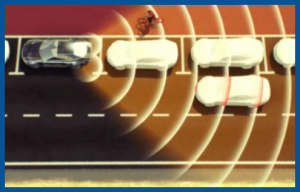
A J.D. Power study found that three of the top five technologies consumers would most like in their next vehicle are related to collision protection.
Hella has started production in Michigan of its latest generation 24GHz radar-based driver-assistance technology adding an “exit alert” function to warn of door openings into cyclists, pedestrians and vehicles. The latest addition to driver assist systems is currently in pre-production status, subject to verification by automakers. Automotive safety systems based on the 24GHz narrow-band frequency can be used almost anywhere in the world and primarily support medium-range rearward-facing applications.
Exit Alert, said to ensure the safety of all road users, builds on already widely produced aids, including blind spot detection, lane change assist, rear cross traffic alert and rear pre-crash braking and safety belt tightening.
A recently published J.D. Power & Associates study found that three of the top five technologies consumers would most like in their next vehicle are related to collision protection. The report claims the technologies consumers express the most interest in are blind-spot detection, night vision, and enhanced collision-mitigation systems. The only non-collision protection technologies cited were camera rearview mirror, which falls into the driving assistance category, and self-healing paint, a comfort and convenience category in Power’s view.
“We have taken a scalable approach with our third generation driver-assistance products, giving automakers the flexibility to offer a variety of driver safety packages to their customers, depending on the vehicle segments involved,” said Hellas’s Robert Hurley, U.S. product line director for Driver Assistance Systems.
Hella, the European market leader for rear-radar systems, is gaining share in North America with global demand for rear-radar applications forecast at 11 million systems by 2019, compared to 4 million in 2014 (Strategy Analytics, May 2015). Since its first generation system was introduced in 2005, major updates have followed.
Hurley said the company also plans to introduce further updates in 2017 and 2018, adding a 24GHz radar system generation 4.0, followed by a 77GHz generation 5.0 that will provide functions in the front of the vehicle.

